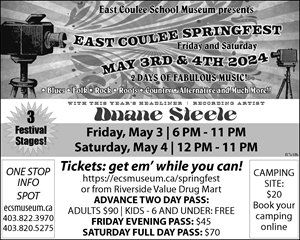
For the many years that Doug Wade has lived in the valley and hiked the hills with explorer zeal, his most recent fossil discovery is an exceptional curiosity.
Doug Wade discovered what he believes to be a fossil on a Monday morning walk near his home east of DVSS. Covered in mud was a heavy horseshoe shaped mass, about 10 inches in diameter. By outward appearances, it looked like at one time bone material.
“When I picked it up and turned it over I saw the bottom and I thought ‘this is weird,’” he tells The Mail. “So I took it home and cleaned it up. It is a bone I believe.”
After cleaning up the find revealed that someone has used a concrete saw to make a clean cut right through the find.
“It makes me curious; Who cut this? When did they cut this? Why did they leave it?” he asks.
He is planning to take the bone to the Royal Tyrrell Museum in hopes they can answer some of his questions about what his find may be.
“I have talked to so many people in the valley who find fossils, often in the spring after the snow and water erosion, lots of these are sitting on the surface,” he said.
Discovering fossils is what makes the valley famous. Dan Spivak, head, resource managements program, at the Royal Tyrrell Museum, reminds hikers there are a few things for amateurs fossil hunters to remember.
“The Alberta Historical Resource’s Act essentially covers the collection and ownership of all historical resources in Alberta. That includes palaeontological resources, to fossils, which we are most familiar with at the museum, But also archeological artifacts, like arrow heads, hammer stones and tipi rings, stuff like that,” said Spivak.
He has some simple advice for people who come across what they believe is a fossil in the backcountry.
“The first thing we generally ask is if it looks like there is more there than just the little bit you see on the surface, leave it where it is. Take a photograph of it, look around and see if there are any landmarks or anything notable that would allow them to get back to it, or allow us to get to the site,” he said. “And then give us a call at the Museum.”
Smart phones can be useful to get a GPS reading of the site, or allow a person to pinpoint it on a map.
Any finds are the property of the province, and in fact, the Museum is located in a provincial park. This means that removing or collecting the find is prohibited.
“There are a lot of people who will come out in the summer and walk the interpretive trails and pick up stuff wanting to take things home. But under the parks act, even picking it up is against the law.”
Outside of the park he said if someone finds something that might be significant, to give them a call.
“One of our curators here handles all those emails regarding fossil identification enquiries,” he said. “Typically if it is something surface collected that is not of significance outside the park, the person who finds it can take it home, put it on their mantle, and let their kids take it for show and tell, they just can’t sell or trade it. They can’t damage it and they can’t take it out of the province.
He says the museum does see evidence from time to time of people illegally collecting fossils. The evidence of the saw cut could be a sign of this.
“Generally people are untrained. It looks rally easy when you watch it on TV or in a documentary but there is a real technique to it to make sure the fossils aren’t damaged,’ he said.
“A lot of the attempts in the valley that I have seen, they tend to be hack jobs. They go in and make more of a mess out of the bones than anything else,” he said.
He encourages those who find something that is curious, to let them know.
“One thing I have learned over my time is never identify a fossil over the phone,” he chuckles. “You see a lot a rocks…but I can’t stress enough, we would rather see 100 of those, and get one really good fossil out of it than not see them at all.”



























